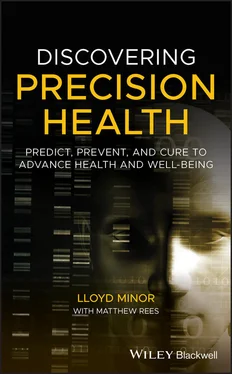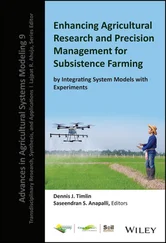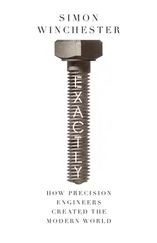Chamberlain also works as a physician at the Gardner Packard Children’s Health Center, a community‐based clinic serving primarily low‐income families. (Her work at Gardner followed 14 years of seeing patients at Ravenswood, a family health center in East Palo Alto.) When she sees children who are starting kindergarten, she ensures that they have the required immunizations and tests their vision and hearing. She also screens them developmentally to check their school readiness skills: Do they know their colors? Can they write their name? In one recent year, she and her colleagues evaluated five‐year‐old children in the clinic, and just 13 percent were ready for kindergarten. (The comparable figure for children attending Palo Alto schools, just a few miles away, is typically 85 to 90 percent.) “Not only are these children starting kindergarten behind,” says Chamberlain, “they’re being set up to fail.”
Among the many health challenges faced by low‐income children are the meals they’re served at school. These meals—which include lunch and sometimes breakfast—often have little or no nutritional value, thus setting the children on a path to weight gain and, potentially, obesity. Low‐quality food is a longstanding problem at schools, but there are entities trying to make a difference. Revolution Foods, for example, works with more than 1,500 schools, spread across 16 states and Washington, DC, and it is focused on providing healthy foods, such as fruits and vegetables.
But bringing healthy food into schools often faces significant obstacles. Chamberlain, for example, tried to get a low‐income district to drop its existing food provider and switch to Revolution. But the existing provider—a national company that provides meals to schools throughout the country—was able to come in at a lower cost, as it provided something that Revolution did not: cafeteria workers. Dropping the national company would lead to the district incurring unsustainable fiscal deficits. The superintendent told Chamberlain, in so many words, “I know these kids need healthier food. But what am I supposed to do? I have enough trouble focusing on academics and everything else. I can’t take on food as well.”
That story is emblematic of the challenges we face in improving the diets of all people, and it’s a potent reminder of how the environment in which you live can have a major influence on your health. There’s considerable evidence that attention to and improvements in the environment and social and behavioral factors lead to better health. Consider Los Angeles in the 1990s. The air quality was poor; now, it’s much improved. A study by investigators at the University of Southern California showed gains in lung function in children that paralleled improvement in air quality in Los Angeles. In 1998, 7.9 percent of 15‐year‐olds had significant lung defects. In 2011, the percentage of 15‐year‐olds with these lung defects had fallen to 3.6 percent [12].
While health challenges are often more pronounced for those with lower incomes, the challenges are embedded in the way most Americans live their lives. We tend to drive much more than we walk. We eat processed food rather than cooking fresh food. We sit in chairs for much of the day, staring at a screen. Increasingly, we do our shopping and get our entertainment without even leaving our homes. While these conveniences certainly have benefits, there are also trade‐offs. One of them is that many researchers believe we now have a culture that is obesogenic (i.e., it contributes to obesity). “Our whole economy is driven toward convenience,” says Abby King, a professor of health research and policy and of medicine at the Stanford School of Medicine, “and convenience often goes hand‐in‐hand with poorer choices in terms of health.”
King is working to remedy this—not by eliminating the conveniences of modern life, but rather by spurring changes to local communities that can contribute to the health of people living in those communities. She and her team are doing this through empowering and activating residents themselves to be part of positive change in their local neighborhoods and communities. The global initiative that she leads, called Our Voice, has completed a range of projects, such as promoting better food and physical activity environments in low‐income sections of California’s San Mateo County [13], increasing the community’s understanding of the variety of foods being offered at farmers’ markets in Arizona [14], and investigating the walkability of higher‐ and lower‐income neighborhoods in Mexico [15]. “We focus on monitoring, nudging, and activating residents to not just change their own behaviors, but also to change the context in which they and their neighbors live,” says King [16].
They describe their efforts as “citizen science by the people,” and the community engagement process begins with a mobile app called the Stanford Healthy Neighborhood Discovery Tool [17]. Using this app, residents walk around their environments and narrate what helps or hinders their health. They then meet with other residents to talk about what they’ve seen and learned, and then learn how to communicate this information and advocate for healthier neighborhoods with local decision makers. “People love to be engaged in this way,” says King, “and see their neighborhood from a different perspective.” Harnessing technology, she says, can help advance the ultimate goal: for everyone to lead healthy, active lives.
King and others are helping us understand the social, environmental, and behavioral determinants of health. This is vitally important, but it is not enough. We must also understand health in its entirety. William Osler, whom I mentioned in the introduction, moved medicine forward with his studies of the natural histories of diseases. Today’s challenge is to understand the natural history of health. To begin to create such a history, researchers from Stanford Medicine and Verily are studying biological markers and recording health data from devices that will be worn by thousands of people. This data is enabling us to understand markers of health trajectories better than ever before.
We are also working to expand the understanding of wellness and well‐being in a larger sense, with a focus on identifying what factors help people maintain health and wellness, in order to develop techniques that will help people to change their lifestyles. The Stanford Prevention Research Center, which I mentioned earlier, is on the frontlines of this effort. John Ioannidis, a professor of medicine at Stanford, is forthright about what he wants to achieve. “This is an effort to change the world of medicine and health,” he says. “I see this as a way to refocus the key priorities of biomedical research.”
The vast majority of biomedical research has focused on treating diseases. A much smaller part has focused on maintaining health and maybe some prevention efforts. But there’s very, very little research that has tried to look at the big picture—what makes people happy, resilient, creative, fully exploring their potential and living not only healthy, but more‐than‐healthy lives [18].
The center’s research has involved enrolling 40,000 people—10,000 each in the United States, China, Taiwan, and Singapore, and possibly also other countries downstream—and asking them 76 questions that are connected to 10 different dimensions of well‐being. Blood samples, as well as other biological samples collected from participants in most sites, will be available to be studied. These analyses, says Ioannidis, may reveal biological markers for wellness and well‐being. “Just as we can monitor diabetes by looking at blood sugar levels, is there some biomarker that can tell us something about how one feels about one’s life? Are there biomarkers that indicate levels of wellness and well‐being and that change as people’s levels of well‐being increase or decrease?”
Читать дальше












